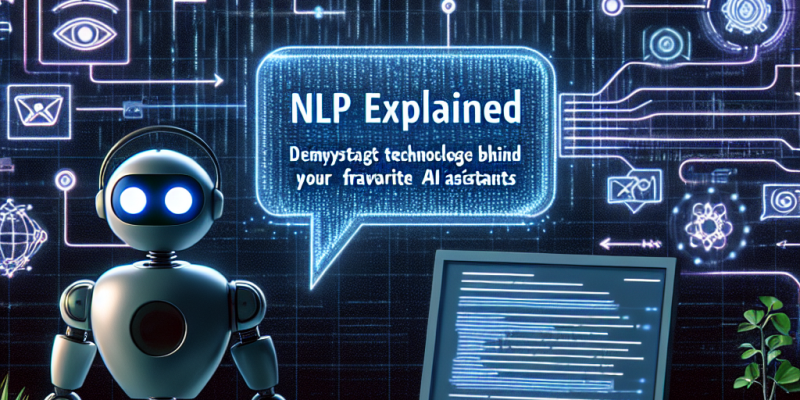NLP Explained: Demystifying the Technology Behind Your Favorite AI Assistants

In an age where technology seamlessly integrates into our daily lives, artificial intelligence (AI) has become a household term, prominently seen in devices and applications we interact with daily. Most of us have had conversations with AI-powered assistants like Apple’s Siri, Amazon’s Alexa, Google Assistant, or Microsoft’s Cortana. But have you ever wondered what powers these digital helpers? The answer lies in a fascinating field of study known as Natural Language Processing (NLP). In this article, we will explore what NLP is, how it works, and its significance in creating conversational AI.
What is Natural Language Processing?
Natural Language Processing is a branch of artificial intelligence that focuses on the interaction between computers and humans through natural language. The goal of NLP is to enable machines to understand, interpret, and respond to human language in a valuable way. By bridging the gap between humans and machines, NLP allows for more intuitive and effective communication.
NLP combines several disciplines, including computer science, linguistics, and machine learning. It encompasses a range of techniques and methodologies that help machines process and analyze vast amounts of natural language data.
The Components of NLP
Understanding NLP involves looking at its key components:
1. Tokenization
Tokenization is the process of breaking down text into smaller units, or tokens, which can be words, phrases, or even sentences. This step is essential for understanding and processing a broader context since it converts human language into a format that machines can analyze.
2. Part-of-Speech Tagging
This step involves identifying the grammatical parts of a sentence, such as nouns, verbs, adjectives, etc. By tagging words based on their parts of speech, the system can better understand the structure and meaning of sentences.
3. Named Entity Recognition (NER)
NER is the process of identifying and classifying key information in text, such as names of people, organizations, locations, and dates. This helps AI assistants provide context-aware responses, facilitating more meaningful conversations.
4. Sentiment Analysis
Sentiment analysis involves determining the emotional tone behind a series of words. This can range from positive, negative, or neutral sentiments, allowing AI to gauge the user’s feelings and tailor responses accordingly.
5. Parsing and Semantic Analysis
Parsing involves analyzing the structure of sentences, while semantic analysis focuses on understanding the meanings of words and phrases in context. Together, these processes enable AI to generate more accurate interpretations of user input.
6. Machine Learning and Deep Learning
Modern NLP heavily relies on machine learning algorithms and deep learning techniques to enhance understanding and responses. By training on vast amounts of textual data, AI systems can learn patterns, context, and nuances that are crucial for natural communication.
The Role of NLP in AI Assistants
AI assistants deploy NLP to facilitate various tasks, such as:
-
Speech Recognition: Converting spoken language into text, allowing users to interact using voice commands.
-
Question Answering: Understanding user queries and delivering relevant answers, whether it’s retrieving facts from the web or performing tasks on devices.
-
Personalization: Tailoring responses based on previous interactions, user preferences, and context analysis to enhance user experience.
- Language Translation: Enabling communication across different languages through real-time translation capabilities, expanding accessibility and understanding.
Challenges in NLP
Despite its advancements, NLP still faces several challenges:
-
Ambiguity: Natural language is often ambiguous, with words having multiple meanings depending on context. This can lead to misunderstandings in AI responses.
-
Sarcasm and Irony: Recognizing sarcasm and irony remains a significant hurdle for NLP systems, as they often rely on tone and context to interpret meaning correctly.
- Cultural Nuances: Language varies significantly across cultures, and AI assistants must navigate these differences to provide relevant and respectful interactions.
The Future of NLP and AI Assistants
As technology continues to evolve, so too will the capabilities of NLP. Advances in AI and machine learning will likely lead to improved language understanding, enabling AI assistants to hold more natural and lifelike conversations. Innovations such as transformers and attention-based models are already transforming how we approach language tasks, increasing the sophistication of these systems.
Moreover, ethical considerations surrounding data privacy, bias in language models, and responsible AI usage will shape the future of NLP technologies. Striking a balance between enhancing user experience and ensuring ethical practices will be key in the journey ahead.
Conclusion
NLP is at the heart of the technology driving your favorite AI assistants. By enabling natural communication between humans and machines, NLP helps streamline tasks, improve efficiency, and create engaging user experiences. As we continue to explore and expand the capabilities of this exciting field, the possibilities for AI-enhanced communication are boundless. Understanding NLP not only demystifies the technology but also opens the door to more profound interactions with the AI we come to rely on every day.














